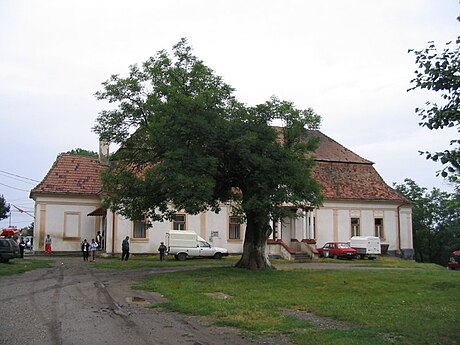Voivodeni (also Sânioana or Sântioana; Hungarian: Vajdaszentivány, Szentivány; German: Johannisdorf, Johannesdorf) is a commune in Mureș County, Transylvania, Romania. It is composed of two villages, Toldal (Toldalag) and Voivodeni.[3][4][5] The former village is much less populated than the latter.
Voivodeni
Vajdaszentivány | |
|---|---|
 Zichy Castle | |
 Location in Mureș County | |
| Coordinates: 46°42′0″N 24°38′0″E | |
| Country | Romania |
| County | Mureș |
| Government | |
| • Mayor (2020–2024) | Vasile Boer[1] (PSD) |
| Area | 34 km2 (13 sq mi) |
| Elevation | 364 m (1,194 ft) |
| Population (2021-12-01)[2] | 1,575 |
| • Density | 46/km2 (120/sq mi) |
| Time zone | EET/EEST (UTC+2/+3) |
| Postal code | 547650 |
| Area code | (+40) 02 65 |
| Vehicle reg. | MS |
| Website | voivodeni |
This a commune is within a region known as Transylvania and is the centrally located in Romania. It is about 174 miles north of Bucharest, about 8 miles southwest of the city of Reghin, about 14 miles north of the county capital of Târgu Mureș, and about 86 miles northwest of Brașov.[6] It is also at an average altitude of 1,230 feet, which is less than the average height where a landmass is considered a mountain (2,000 feet).
The commune has a hemiboreal climate with the average temperature as 48 °F (9 °C), with the warmest in July at about 70 °F (21 °C) and the coldest in December at about 21 °F (−6 °C).[7][8][9] The average rainfall is about 31 inches a year, with about 5 inches in May and about 1.5 inches in February on average.
History
The first mention of the town was in 1332, under the name of Sancto Johanne.[10][11] Archaeological finds have shown that the area comprising the Voivodendi village was first settled during the Bronze period. Find have showed settlement on a hill called Benghát, 374 metres (1,227 ft) tall, and Roman presence as made clear by an existing Roman road nearby. In the commune town of Toldal, there is definite finds of Roman settlers, who focused on agricultural production.
During the Kingdom of Hungary, the commune belonged to the Régen district. It had been was part of the Székely Land region of the historical Transylvania province. This was kept when the Kingdom was absorbed into the Austrian Empire and the Austro-Hungarian Empire. For instance, in 1876, there was an administrative reorganization of Transylvania, and it was attached to Maros-Torda County.
After the Hungarian–Romanian War of 1918–1919 and the Treaty of Trianon of 1920, the commune became part of the Kingdom of Romania, and was attached to Mureș County. In 1940, the Second Vienna Award granted Northern Transylvania to Hungary and the locality was held by Hungary until 1944. During this time, the small Jewish community in the area was exterminated by the Nazis. After Soviet occupation, the Romanian administration returned and the village became officially part of Romania in March 1945. Between 1952 and 1960, the commune fell within the Magyar Autonomous Region, between 1960 and 1968 the Mureș-Magyar Autonomous Region. In 1968, the region was abolished, and since then, the commune has been part of Mureș County.
The commune features the Zichy Castle, with relics from the Roman area and Hungarian presence.[12] Notable people who have lived in the commune include politician István Dán and biologist (and geographer) Pál Samu, born on June 28, 1935.
Demographics

The highest number of people living in the commune, since recording of population information began in 1850, was in 1956, with a total of 2,849 inhabitants.[13][14][15][16][17]
According to the 2011 census, the population of the Voivodeni commune was 1,756 inhabitants.[18] This was a decrease from the last census, in 2002, when 1,957 were living in the commune. Of the inhabitants, about 60% were Hungarian, while the rest were either Romanian (28.4%) or Roma (9.05%), with about 2% having an unknown ethnicity.[19] This means that the commune has a (Székely) Hungarian majority.
In terms of religious belief, most are Reformed (about 57%), while the rest are either Orthodox (about 28%), Seventh-Day Adventists (about 4%), Jehovah's Witnesses (3.4%), Roman Catholic (2.5%), or non-religious (1.6%).[20] About 2% of the population had religious beliefs that cannot be determined.
Present day

The commune of Voivodeni is administered by a mayor and a local council which is composed of 11 councilors. The Mayor is Vasile Boer, from the Social Democratic Party, who was elected in 2012. The local council has the following composition of political parties after local elections in 2016:[21]
- Social Democratic Party (Romania) – 7 seats
- Hungarian Democratic Union of Romania – 3 seats
- Hungarian Civic Party – 1 seat
Dance classes are held in the commune, like other parts of Transylvania, and churches made of wood are still standing.[22][23] The economy of the town is based on agriculture and livestock. The municipality is also located on the regional road DJ154J Breaza – Glodeni, near the national road DN15 Târgu Mureș – Reghin.
Tourist attractions in the commune include the Reformed-Calvinist Church in the village of Voivodeni, built in the 15th century, and the Zichy Mansion in Vojvodina, constructed in the 18th century, to name two historical monuments.[24][25] There are also several lakes, like Lacul Sate, where tourists can fish.
See also
References
External links
Wikiwand in your browser!
Seamless Wikipedia browsing. On steroids.
Every time you click a link to Wikipedia, Wiktionary or Wikiquote in your browser's search results, it will show the modern Wikiwand interface.
Wikiwand extension is a five stars, simple, with minimum permission required to keep your browsing private, safe and transparent.


